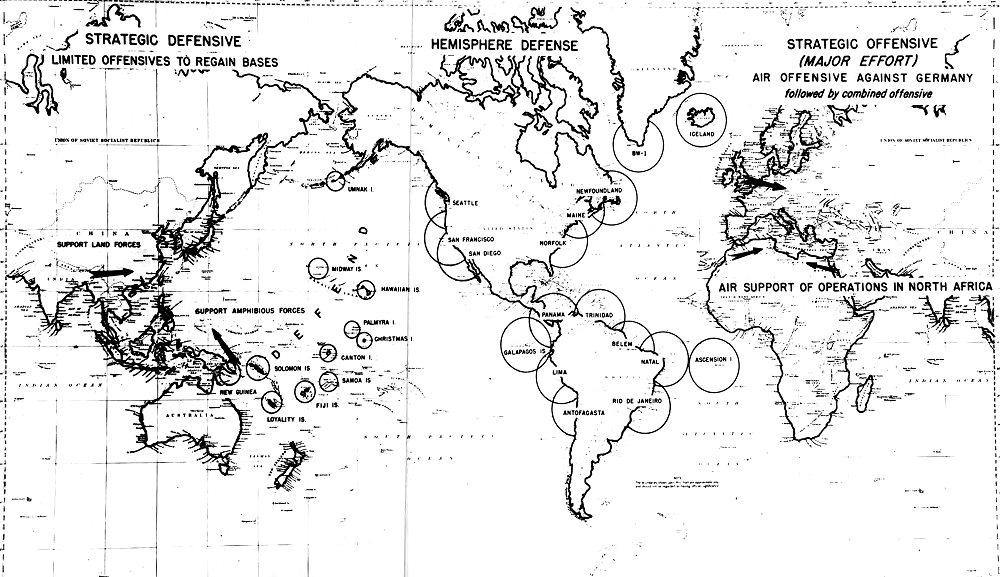
A.W.P.D.-42Strategic Air Concept |
1. Strategic Situation.
It is assumed that, by the end of 1943, German operations against Russia will have been sufficiently successful to permit the release of half the German forces now engaged on the Russian front, for employment elsewhere.
It is further assumed that:
Our operations in North Africa have given us control of French Morocco and Algiers, and that our forces control the south shore of the Mediterranean, at least as far as, and including Tunisia.
United Nations forces are engaged with Axis forces somewhere in the Middle East, and that India is still controlled by the United Nations.
Our forces have made some progress toward regaining the lost base areas in the Japanese Theater, but that Japan still holds the majority of her conquests.
Siberia probably is not available as a base area. However, forces will be provided for operations from Siberia in case it should be available.
Under these circumstances it may be anticipated that the relative strength of the opposing land and air forces is approximately as follows, by the and of 1943:
|
Locality |
Divisions |
Airplanes |
||
|
United Nations |
Axis |
United Nations |
Axis |
|
|
Western Europe ) |
87 |
245 |
15,700 |
7,500 |
|
Far East |
56 |
44 |
9,400 |
2,000 |
Under these conditions, it is apparent that the United Nations will be unable to launch a land offensive in Europe, unless the war-making capacity of the Axis powers is undermined.
On the other hand, the United Nations enjoy an increasing superiority in air power and possess a base (England) which is within striking distance of the vital elements of Germany and is capable of sustaining powerful air forces.
In the Japanese Theater, we would be unable to attack the real sources of Japanese strength, in Japan Proper, except by very long range bombers (B-29 type). It is doubtful whether these bombers could be made available in sufficient quantity by the end of 1943 to have a decisive influence on Japan.
2. Grand Strategy.
The Combined Chiefs of Staff recently expressed the following strategic concept (C.C.S. 91):
Consideration of the foregoing leads to reaffirmation of the previous strategic concept for the United Nations:
To conduct the strategic offensive with maximum forces in the Atlantic-Western European Theater at the earliest practicable date, and to maintain the strategic defensive in other theaters, with appropriate forces.
To implement the strategic concept our land, sea and air forces should be disposed to effectuate the following main courses of action:-
Strategic Offensive.
(a) Initiate a major combined offensive against Germany in the European theater. Plans to be flexible so as to meet the situations if Russia should collapse.
(b) Wear down and undermine German resistance by increasing bomber offensive, blockade, raids, subversive activities and propaganda.
(Note: These courses of action in the Strategic Offensive must be reversed, from a chronological point of view, since a successful air offensive is a necessary preliminary to success in a Combined Operation involving land, sea, and air forces.)
Strategic Defensive.
(c) Secure essential land, sea and air communications of the United Nations, particular emphasis being placed on an increasing anti U-boat offensive.
(d) Secure the Middle East.
(e) Secure Ceylon and stop the Japanese penetration towards India and the Indian Ocean.
(f) Secure Australia, New Zealand, Hawaii and Alaska.
(g) While the above strategic defensive roles are being carried out, employ amphibious forces in the Pacific theater on limited offensive operations. At the same time inflict attrition and exert economic pressure on Japan.
(h) Without prejudice to (a) above, prepare to reoccupy Burma in order to reopen land communications with China.
